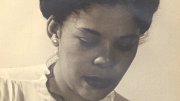Unlike many aspiring artists who move to New York, Ann (Lane) Petry did not come in search of celebrity or fame. She left her hometown of Old Saybrook, Connecticut, for Harlem in 1938 to join her new husband, George, to escape the expectations of her middle-class family, and to pursue her literary ambitions. Yet in less than a decade, she would become the most successful black woman writer of her day. The 1946 publication of her first novel, The Street, gained her widespread (and ultimately unwanted) attention as a writer and cultural figure.
The youngest daughter of a pharmacist father and entrepreneurial mother, Petry was herself a professional pharmacist who began writing short stories while working in her father’s store. When she abandoned the family business for New York, she quickly found work as a journalist. Her early years in Harlem were fueled by involvement in progressive political causes and membership in a community of activists, labor leaders, visual artists, actors, and writers. Despite working closely with self-identified Communists, Petry never affiliated with the party and resisted efforts to enlist her as a fellow traveler. She maintained her distance, and managed to be quite a loner in the midst of the city’s crowd.
Harlem inspired Petry. The legendary black neighborhood provided the imagery, drama, incidents, and language for a body of work that included journalism, essays, and short stories, as well as the novel. Her fiction of the period features ordinary, law-abiding, working-class African-American protagonists: most start off devoted to hard work and driven by middle-class aspirations, with a strong belief in the American Dream. But as they are thwarted at every turn by individual and institutional racism and, in the women’s cases, by violent sexism, they end up resigned, filled with despair, and often engaged in destructive, sometimes violent, acts.
Lutie Johnson, the protagonist of The Street, is a beautiful single mother who strives to leave domestic service for more lucrative employment. Her idea of success is inspired by Benjamin Franklin’s autobiography, an Italian immigrant shopkeeper, and her wealthy white employers, all of whom encourage her to work, save money, and create a better life for her child in this “best country in the world.” But these mentors fail to warn her of the pitfalls and obstacles that await her as a working-class black woman. She is under surveillance by a predatory neighbor, stalked by her building’s superintendent, and watched, cultivated, and trapped like prey by a white man who owns her apartment building as well as the club where she hopes to work. She has nowhere to run, nowhere to hide.
The Street became the first novel by a black American woman to sell more than a million copies. It was widely reviewed, published in several paperback editions, and translated into French, Spanish, Japanese, and Portuguese. Its author appeared on magazine covers and in a glossy feature article in Ebony magazine.
But as her literary celebrity grew and as the specter of a second Red Scare began to rise, Petry and her husband returned to Old Saybrook in 1947, purchased a home, and avoided publicity except as it related directly to her writing. Some of this insistence on privacy no doubt came from a desire to protect herself. Her New York years had been filled with leftist friends and colleagues; she despised the anticommunist fervor that swept the nation in the 1950s and openly supported Paul Robeson, whose life and career it destroyed. Petry’s third, and most ambitious, novel, The Narrows, published in 1953, set in a small Connecticut town, articulates her disdain for McCarthyism, which “hunts” both “Communists and Negroes.”
Yet Petry’s retreat from public life was also nurtured by her own sensibilities. She refused to reveal her personal life to reporters and scholars alike, believing that she had to choose between becoming a “celebrity” or a “writer”—concepts fundamentally incompatible in her mind. She described the hoopla that followed publication of The Street as turning her into “public property”; time and again, the phrase pops up in her personal papers and in conversations revealed by her only child, Elisabeth. As late as 1996, a half-century after the novel appeared, she told a radio interviewer, “Continuous public exposure, though it may make you a ‘personality,’ can diminish you as a person. To be a willing accomplice to the invasion of your own privacy puts a low price on its worth. The creative processes are, or should be, essentially secret, and although naked flesh is now an open commodity, the naked spirit should have sanctuary.” She so feared the possibility of exposure that she destroyed much of her own writing, including letters and journals.
Born of generations of black New Englanders, many of them property- and business-owners, Petry could have seen property ownership as the only avenue to ensure independence and autonomy. She had lived, after all, in a Harlem populated and energized by black people, but not owned by them. For Petry self-ownership, including the right to privacy, was a priority of those—like black people and women—who had legally been the property of others. Self-ownership was a personal, political, even a spiritual necessity. It was an effort to reclaim herself, to reserve space for the creation of her work, and an effort to ensure that the work be valued and judged on its own terms.









